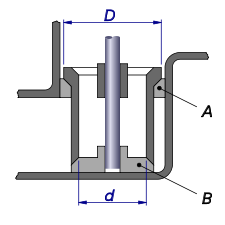- Double beat valve
-
The double-beat valve, drop valve or equilibrium valve is a type of poppet valve arranged to allow it to be opened against a high pressure with a minimum of force.
One of its uses is in steam engines to admit steam to the cylinders and to release the exhaust. In stationary steam engines it is usually operated by trip valve gear while in railway locomotives a valve gear such as Caprotti is used.
It was invented around 1800 by Jonathan Hornblower.[1]
His valve is in the form of a hollow cylinder provided with two seats of nearly equal diameter, at A and B in the diagram[1]. The cylinder is connected to the actuating rod by a web. The force required to lift the valve depends on the difference between diameters D and d: the smaller this difference can be made, the less the force necessary to open the valve.
In Hornblower's valve, the steam flows past seat B only. In later developments of the valve, the central portion is waisted so that the flow can pass at A as well, so increasing the valve opening area for the same amount of lift.
References

This article about a mechanical engineering topic is a stub. You can help Wikipedia by expanding it.

